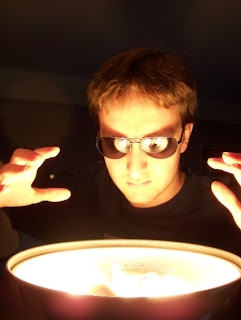When I'm asked what my favourite game is, I have to pause a moment, searching through the usual suspects - Tetris, Zelda:ALTTP - before I remember with a comforting lurch that it's Street Fighter II. I spent pretty much every day playing it on the SNES from 11 to 18. My experience is not unique; it's common among my friends, and pretty much every boy born at the right time. SFII is our Star Wars. No little attention, then, for the first new instalment in the Street Fighter series for years in Street Fighter IV.
First impressions of SFIV are great: the feel of SFII is retained, in both aesthetic and control. A few faces look odd, but the cartoon faces shown in stills look fine at 60 fps. The new characters aren't quite right, perhaps just the wrong side of silly in two cases, but aren't far off: those characters new to returning SFII players (Sakura, Dan et al) balance it out. Things are close enough to SFII to match exactly the game through the fog of memory, without making exactly the same choices - it's certainly not SFII and a bit.
There are a *lot* of new systems in SFIV. The revenge mater and its ultra attacks, focus attacks, dashes and their mutant offspring the FADC are all new, and if you're just tuning in from SFII, you've also got super attacks, EX specials and overhead attacks to deal with, not to mention brand-new plain-old specials. When you consider that a game like Tekken doesn't even distinguish between "normal" and "special" attacks any more, having four distinct levels of special move that draw from two different bars that must be charged is a lot to take in. Trying to explain it all to a beginner is too much, and you really do need most of it to stand a chance. With, say, Soul Calibur, you can show the basic controls - pointing out "block" three times - and someone can work it out from there: the attack strings are fairly arbitrary anyway. With Street Fighter - this is not new to SFIV - not knowing how to throw a fireball is a crippling disadvantage, and you can't really work it out. Having so many new systems makes this problem large. The upshot is that SFIV is easy to get good at if you're trying, but very difficult if you aren't.
Is this a bad thing? Probably not: SF is not for casual players. It's based on a set of interacting systems, and learning the systems is necessary to a reasonable level of competition. It's no different from learning to dribble in basketball, or serve and return in tennis: certain skills are required in order to play the game at all. SF sets its bar a little higher than other games: SFIV sets it higher than in the earlier games. It is an intentional point of this game to emphasise the skill involved in playing a fighting game well.
SFIV has made an energetic and slightly tumultuous start with the hardcore fighting games community. Given the level of hype it was always due for prominence as long as it was a good game: early play shows some surprises in weak and strong characters, and some scary combos. David Sirlin has already pointed out the number of link combos, high-difficulty sequences that lead to massive damage off quick attacks. That suggests a fast and lethal game for the highly-skilled, and a high barrier for the not-so-highly skilled. Again, this is not unlike other contests of skill: Roger Federer may be a top 10 tennis player because of his ability to read, react to and control the movement of his opponent, but he's a top 100 player because he can smack a forehand onto a 3" square spot really hard without trying. Mental ability separates the best, but physical excellence is the invitation to compete.
There are a couple of clunking errors of execution. Capcom seem obsessed with a terrible system of button selection, in which you cycle through which button does what. It's a bad error to lock certain characters, especially for a versus competitive game: hiding Gouken was a lovely surprise in the arcade (and what a lovely surprise Gouken is), but a chore in the home version. Finally, Seth's a mistake. Too powerful to allow, he will be the cause of arguments in the house of every version in which he is unlocked. As Dan proves, an underpowered option does not wreck a strategic decision, but an overpowered one does. Besides, a pick-and-choose superhuman clone weapons programme is just *lazy*. Previous SF bosses were Sagat, Bison and Urien, all amazing and unique character designs. Seth is a feeble addition to SF canon and won't be missed.
It says something however, that locking 9 of 25 characters from the first play, and making a character far too good to be allowed by anybody reasonable, are mistakes I'm willing to forgive (though not forget). SFIV has three main aims: to please the old SFII fans led away by Tekken and Soul Calibur from SFIII and the terrible EX series; to give the hard-core community a substantial new series to master, and also to draw more intermediate players into serious play. The first two points I have already addressed, but perhaps the success on the third point can be measured by the demand for not just arcade sticks, but even Sanwa and Seimitsu buttons and parts.
